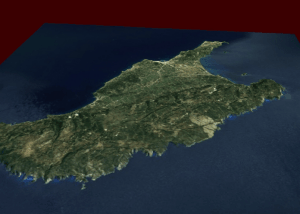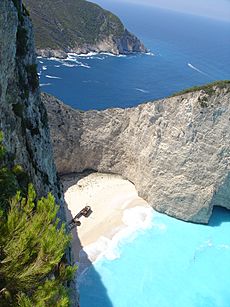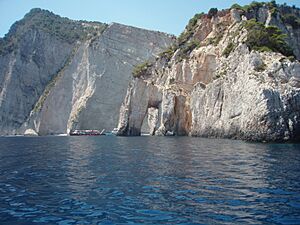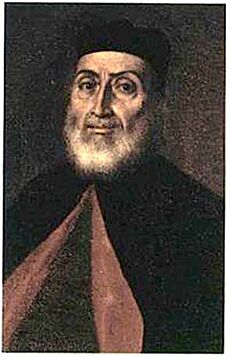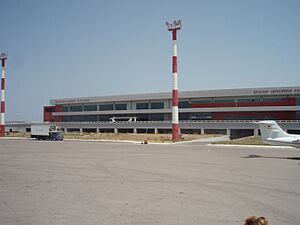Zakynthos facts for kids
Quick facts for kids
Zakynthos
Ζάκυνθος
|
|
|---|---|

View of Zakynthos city
|
|
| Country | Greece |
| Administrative region | Ionian Islands |
| Area | |
| • Total | 405.55 km2 (156.58 sq mi) |
| Population
(2021)
|
|
| • Total | 41,180 |
| • Density | 101.541/km2 (262.99/sq mi) |
| Time zone | UTC+2 (EET) |
| • Summer (DST) | UTC+3 (EEST) |
| Postal code |
29x xx
|
| Area code(s) | 2695 |
| Vehicle registration | ΖΑ |
Zakynthos (also called Zakinthos or Zante) is a beautiful Greek island in the Ionian Sea. It's the third largest of the Ionian Islands, covering about 405.55 square kilometers (156.6 sq mi). Its coastline is about 123 kilometers (76 mi) long. The island's name comes from ancient times, possibly from a legendary chief named Zacynthus.
Zakynthos is a very popular place for tourists, especially from the UK. It has an international airport that welcomes many flights from northern Europe. The Venetians, who ruled the island for a long time, called Zakynthos "the Flower of the Levant."
Contents
History of Zakynthos
Ancient Times
The famous Greek poet Homer wrote about Zakynthos in his epic poems, the Iliad and the Odyssey. He said the first people on the island were led by Zakynthos, the son of King Dardanos. The island was even mentioned as taking part in the Trojan War! In the Odyssey, Homer talks about 20 important men from Zakynthos who wanted to marry Penelope, the wife of Odysseus.
Later, Zakynthos made an alliance with Athens during the First Peloponnesian War (around 459-446 BC). This was important because Zakynthos had a special kind of tar. This tar was better than regular pitch for protecting wooden ships from rotting and worms. The Athenians needed this tar for their powerful navy. The tar was collected from the bottom of a lake (now called Lake Keri) using tree branches.
The island was later taken by Philip V of Macedon in the early 200s BC. Then, the Romans, led by Marcus Fulvius Nobilior, finally conquered Zakynthos in 191 BC.
Middle Ages
In 459 AD, the island was attacked by the Vandals. During the Byzantine period (from the 600s to 1100s), Zakynthos was part of a larger area called the Theme of Cephallenia. In 1185, it was captured and became part of the County Palatine of Cephalonia and Zakynthos.
Venetian Rule and Modern Era
The Ottoman Empire took control of Zakynthos in 1478, but the Republic of Venice conquered it back in 1482. The Venetians ruled Zakynthos until 1797. After that, the island changed hands several times. It was ruled by the French, then became part of the independent Septinsular Republic in 1800, and then went back to French rule. The British took control in 1809, and Zakynthos became part of the United States of the Ionian Islands. Finally, in 1864, Zakynthos joined Greece.
World War II and the Rescue of Jews
During World War II, when Greece was occupied by Axis forces, something amazing happened on Zakynthos. The German army ordered Mayor Loukas Karrer and Bishop Chrysostomos Dimitriou to give them a list of all the Jewish people living in the town. The Germans wanted to send them to terrible camps.
But the mayor and the bishop bravely refused! Instead, they hid all 275 Jewish people from Zakynthos in villages around the island. Because of their courage, every single Jewish person on Zakynthos survived the war. Both the mayor and the bishop were later honored for their heroic actions. This was very different from other parts of Greece, where many Jewish people were sadly taken away.
Earthquakes on Zakynthos
Zakynthos has experienced strong earthquakes. On August 12, 1953, a very powerful earthquake (7.3 magnitude) hit the island. It destroyed most of the buildings. Since then, all new buildings have been built much stronger to protect against future tremors. Another earthquake happened on October 26, 2018, but thankfully, no one was hurt, though some damage occurred.
Geography of Zakynthos
Zakynthos is located in the eastern part of the Ionian Sea. It's about 20 kilometers (12 mi) west of mainland Greece. The island of Kefalonia is about 15 kilometers (9 mi) to the north. Zakynthos is shaped a bit like an arrowhead, with its tip pointing northwest.
The western part of the island is a mountainous area with high cliffs along the southwest coast. The eastern part is a flat, fertile plain where many people live. This area has long sandy beaches and some hills. The highest point on the island is Vrachionas, which is 758 meters (2,487 ft) tall.
The capital city is also called Zakynthos. It's on the eastern coast and is sometimes called Chora, which means "the Town" in Greece. The main port in Zakynthos city connects the island to Kyllini on the mainland. Another ferry connects the village of Agios Nikolaos to Argostoli on Kefalonia.
Plants and Animals
The island has a mild Mediterranean climate with plenty of rain in winter. This makes the island very green and full of plants. The main farm products are olive oil, currants, grapes, and citrus fruits. The Zante currant is a small, sweet, seedless grape that originally came from Zakynthos.
The Bay of Laganas is home to the first National Marine Park in Greece. This is a very important place because it's the main nesting area for loggerhead sea turtles (Caretta caretta) in the Mediterranean Sea. These turtles come to the beaches here to lay their eggs.
Climate
Zakynthos has a hot-summer Mediterranean climate. This means it has hot, dry summers and mild, rainy winters. Like most of the Ionian Islands, it gets a good amount of rain in winter, but summers are mostly hot and sunny. The average yearly temperature is about 18.5°C (65.3°F).
| Climate data for Zakynthos 1961–1990 (extremes 1961–present) | |||||||||||||
|---|---|---|---|---|---|---|---|---|---|---|---|---|---|
| Month | Jan | Feb | Mar | Apr | May | Jun | Jul | Aug | Sep | Oct | Nov | Dec | Year |
| Record high °C (°F) | 20.2 (68.4) |
22.8 (73.0) |
24.2 (75.6) |
29.8 (85.6) |
35.0 (95.0) |
39.4 (102.9) |
42.2 (108.0) |
40.0 (104.0) |
36.8 (98.2) |
32.0 (89.6) |
26.6 (79.9) |
22.2 (72.0) |
42.2 (108.0) |
| Mean daily maximum °C (°F) | 14.4 (57.9) |
14.5 (58.1) |
16.1 (61.0) |
18.9 (66.0) |
23.4 (74.1) |
27.8 (82.0) |
30.7 (87.3) |
30.6 (87.1) |
27.6 (81.7) |
23.0 (73.4) |
19.0 (66.2) |
15.8 (60.4) |
21.8 (71.2) |
| Daily mean °C (°F) | 11.3 (52.3) |
11.5 (52.7) |
12.9 (55.2) |
15.5 (59.9) |
19.8 (67.6) |
24.1 (75.4) |
26.7 (80.1) |
26.6 (79.9) |
23.8 (74.8) |
19.6 (67.3) |
15.8 (60.4) |
12.8 (55.0) |
18.4 (65.1) |
| Mean daily minimum °C (°F) | 8.1 (46.6) |
8.2 (46.8) |
9.2 (48.6) |
11.1 (52.0) |
14.4 (57.9) |
18.2 (64.8) |
20.4 (68.7) |
20.9 (69.6) |
18.8 (65.8) |
15.7 (60.3) |
12.5 (54.5) |
9.6 (49.3) |
13.9 (57.0) |
| Record low °C (°F) | −2.6 (27.3) |
−2.0 (28.4) |
0.0 (32.0) |
2.6 (36.7) |
5.0 (41.0) |
8.4 (47.1) |
12.0 (53.6) |
13.4 (56.1) |
10.0 (50.0) |
5.2 (41.4) |
2.8 (37.0) |
0.2 (32.4) |
−2.6 (27.3) |
| Average precipitation mm (inches) | 150.4 (5.92) |
112.8 (4.44) |
89.6 (3.53) |
51.3 (2.02) |
17.0 (0.67) |
7.2 (0.28) |
5.0 (0.20) |
9.1 (0.36) |
25.4 (1.00) |
146.5 (5.77) |
159.1 (6.26) |
169.9 (6.69) |
943.3 (37.14) |
| Average precipitation days (≥ 1.0 mm) | 12.8 | 11.3 | 8.2 | 6.1 | 2.5 | 1.1 | 0.5 | 0.9 | 2.8 | 8.1 | 11.0 | 13.2 | 78.5 |
| Average relative humidity (%) | 74.3 | 72.8 | 72.8 | 71.7 | 67.8 | 62.8 | 59.3 | 61.2 | 66.7 | 71.7 | 76.0 | 75.3 | 69.4 |
| Source: NOAA, Info Climat extremes 1991-present | |||||||||||||
Famous Sights
One of the most famous places is Navagio beach, also known as Shipwreck Beach. It's a beautiful cove on the northwest shore, surrounded by high cliffs. You can only get there by boat. There are also many natural "blue caves" carved into the cliffs around Cape Skinari. Small boats can take tourists inside these amazing caves.
Keri, in the south, is a mountain village with a lighthouse. The entire western coast, from Keri to Skinari, has cool rock formations and arches.
The northern and eastern shores have many wide, sandy beaches. Some of these beaches are very popular with tourists in the summer. The biggest resort area is Laganas. Marathonissi islet, also called "Turtle Island," is near Limni Keriou. It has tropical plants, clear turquoise water, beaches, and sea caves. Above Zakynthos town, Bochali hill has a small Venetian castle.
How Zakynthos is Governed
Zakynthos is its own regional unit within the Ionian Islands region. It's also the only municipality in that regional unit. The main town, Zakynthos, is where the government is located.
In 2011, a government reform created the current municipality of Zakynthos. It was formed by combining six older municipalities:
- Zakynthos (city)
- Alykes
- Arkadioi
- Artemisia
- Elatia
- Laganas
Population and People
Here's how the population of Zakynthos has changed over the years:
- 1889: 44,070 (island), 18,906 (city)
- 1896: 45,032 (island), 17,478 (city)
- 1900: 42,000
- 1907: 42,502
- 1920: 37,482
- 1940: 42,148
- 1981: 30,011
- 1991: 32,556 (island), 13,000 (city)
- 2001: 38,596
- 2011: 40,759
- 2021: 40,508
Zakynthos is one of the few areas in Greece where the population is growing. In 2006, there were more births than deaths on the island. The number of people living in rural areas of Zakynthos is growing even faster than in the urban areas.
Culture
Literature
Because Zakynthos was ruled by the Venetian Republic for a long time, it had closer connections to Western literature than other Greek areas.
One of the earliest literary works from the island is the Rimada, a poem from the 1500s about Alexander the Great. Important early writers include Tzanes Koroneos and Markos Defaranas. Pachomios Roussanos was a scholar and theologian.
Later, a group of writers called the Heptanese School of Literature developed. They wrote lyrical and satirical poetry, similar to the Romantic style popular in Europe. They also helped develop modern Greek theater. A very important poet from this school was Dionysios Solomos, who was from Zakynthos. Another was Nikolaos Koutouzis, who was also a famous painter.
The 1998 novel 'Fugitive Pieces' by Anne Michaels has a part set on Zakynthos during the Nazi occupation. It tells the story of a young Jewish boy who was hidden by local families. The book mentions how Mayor Karrer and Archbishop Chrysostomos bravely refused to help the Germans.
Getting Around Zakynthos
The island has a network of roads, especially in the flat eastern part. Main roads connect the capital city to Volimes in the north, Keri in the south, and the Vassiliki peninsula in the west.
Zakynthos has one airport, Zakynthos International Airport, which opened in 1972. It's about 4.3 kilometers (2.7 mi) from Zakynthos town. It has flights to other Greek airports and many charter flights for tourists.
The island also has two ports. The main port is in the capital city and connects to the port of Kyllini on the mainland. Another port in the village of Agios Nikolaos connects to the island of Kefalonia.
Science and Education
The Ionian University has a Department of Environment located on Zakynthos since 2003. They have laboratories and field stations on Zakynthos and the nearby Strofades islets.
Because freshwater is limited on Zakynthos, a special Greek-Norwegian educational project is being set up. The Science Park Zakynthos is a partnership between the Technological Educational Institute of the Ionian Islands, the Norwegian University of Life Sciences, and a local family farm.
Famous People from Zakynthos

Many famous people come from Zakynthos. One of the most well-known is the 19th-century poet Dionysios Solomos. His statue is in the main town square. The Italian poet Ugo Foscolo was also born in Zakynthos and wrote a poem about the island.
The famous Renaissance surgeon and anatomist Andreas Vesalius died on Zakynthos after his ship was wrecked. He was on a trip to the Holy Land. His body is believed to be buried on the island, but the exact spot is now lost. The early 19th-century poet and playwright Elizabeth Moutzan-Martinegou was also born there.
Tourism on Zakynthos
The Museum of Solomos and Eminent Zakynthians is located in St Mark's plaza. It displays local art from the 1700s and 1800s, sculptures, musical instruments, and ceramics. It especially highlights the works of Dionysios Solomos and Andreas Kalvos.
Since the mid-1980s, Zakynthos has become a very popular place for young tourists (aged 18-30). Areas like Alykanas and Laganas, which used to be quiet villages, are now full of hotels, nightclubs, bars, and restaurants.
International Connections
Zakynthos has a special connection with another place, called a twin town:
 Serravalle, San Marino (since 2014)
Serravalle, San Marino (since 2014)
See also
 In Spanish: Zacinto para niños
In Spanish: Zacinto para niños



